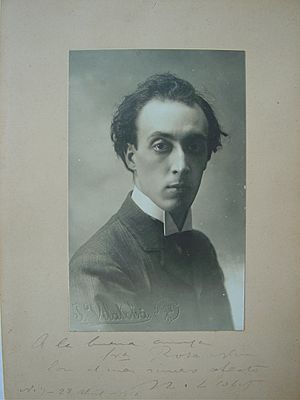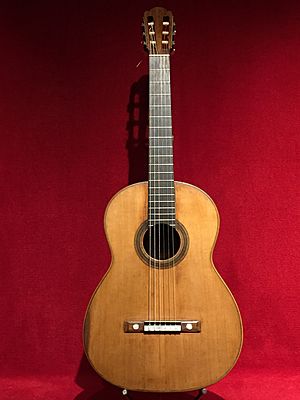Miguel Llobet facts for kids
Quick facts for kids
Miguel Llobet
|
|
|---|---|

Portrait of classical guitarist/composer Miguel Llobet dated 1916
|
|
| Background information | |
| Born | 18 October 1878 Barcelona, Spain |
| Died | 22 February 1938 (aged 59) Barcelona, Spain |
| Genres | Classical music |
| Instruments | Classical Guitar |
| Labels | Chanterelle Verlag, Odeon-Parlophone, Decca |
Miguel Llobet Solés (born October 18, 1878 – died February 22, 1938) was a famous classical guitarist and composer. He was born in Barcelona, Spain. Llobet was known as a virtuoso, which means he was extremely skilled at playing the guitar.
He traveled all over Europe and America, performing for many people. Miguel Llobet also created well-known versions of Catalan folk songs for the guitar. He arranged piano music by Isaac Albéniz for the guitar, and these arrangements became very famous. He also wrote his own original music.
Contents
Miguel Llobet's Life Story
Miguel Llobet's early life details can be a bit confusing. He was the son of a gilder, someone who applies gold leaf. He grew up on Carrer de la Palma de Sant Just in Barcelona. This street was close to where his future teacher, Francisco Tárrega, lived.
Early Talents and Music Lessons
Llobet was also a talented artist and enjoyed painting throughout his life. His first music lessons were on the violin and the piano. Later, his uncle gave him a guitar as a gift. In 1889, Llobet heard a guitar concert by Antonio Jiménez Manjón. This inspired him to start learning the guitar from Magí Alegre.
Learning from a Master
Llobet first met the great guitar teacher Francisco Tárrega in 1892. Two years later, he began studying with Tárrega at the Municipal Conservatory of Music in Barcelona. Llobet said that his studies with Tárrega were not like a strict method. Instead, he would watch Tárrega play and then try out the techniques at home. He learned by experimenting with his own guitar playing.
Starting a Concert Career
In 1898, Llobet began playing private concerts for small groups. Around this time, he met Concepción Gómez de Jacoby. She was a supporter of Tárrega and later helped Llobet start his international career. She took him to Málaga and then to Paris in 1900. This was his first time performing outside the Barcelona area.
His first public concert was in 1901 in València. That same year, he performed in Seville and Málaga. He even earned the special title of Professor. He played at the Teatro de la Comedia in 1902 and for the Spanish Royal Family in Madrid in 1903.
Traveling the World to Play Guitar
In 1904, Llobet had his first concert outside Spain in Paris. The famous pianist Ricardo Viñes helped him with this. Llobet liked Paris so much that he moved there in 1905. He performed in important places like the Schola Cantorum. He lived in Paris until about 1910.
He then traveled and performed throughout South and Central America and the Caribbean. In 1912, Llobet played his first concerts in the United States. He performed in Boston, Philadelphia, and New York City. After this, he returned to Paris.
In the years that followed, he continued to perform across Europe. He played in Belgium, the Netherlands, and Germany. When World War I started, Llobet returned to the Americas for more tours.
Teaching and Recordings
Around 1915, Llobet taught his most famous student, Andrés Segovia. Segovia later became a very famous guitarist himself. Some people believe Llobet greatly influenced Segovia's playing style.
In 1915, Llobet tried to make recordings in New York. However, he was not happy with how they sounded. He also toured the East Coast of the United States in 1912, 1914, and 1917.
In the early 1920s, Llobet played concerts in Spain and toured Germany and Austria. In 1925, he toured the Americas again. He returned to the Americas in 1930 to perform for the Spanish Arts Festival.
In 1923, he began teaching María Luisa Anido in Buenos Aires. By 1925, they were performing guitar duets together. They also recorded some of Llobet's duet arrangements. Llobet also made solo recordings, which were some of the first classical guitar recordings ever released.
Later Life and Legacy
Llobet toured Europe again in 1930-1931. He performed in cities like London, Berlin, and Vienna. The composer Paul Hindemith heard him play in Berlin and wanted to write music for the guitar.
From 1932 to 1934, Llobet taught the young Cuban guitarist José Rey de la Torre at his home in Barcelona. Llobet did not perform as much during this time. He preferred a quieter life, but he still met with other artists.
Miguel Llobet died on February 22, 1938, in Barcelona. He passed away from a lung illness called pleurisy. His health may have been affected by the difficult times in Barcelona during the Spanish Civil War.
His complete musical works have been published. Many of his original handwritten music sheets are kept in the Miguel Llobet Collection at the Museu de la Música in Barcelona.
Miguel Llobet's Guitars

Miguel Llobet used several guitars during his career. One of his favorites was made by Antonio de Torres in 1859. He loved its sound so much that he refused to fix a small crack in it, fearing it would change the guitar's beautiful tone.
Some of his guitars are now part of the Miquel Llobet Collection at the Museu de la Música de Barcelona. You can find them in their online catalog.
Other guitars he used include:
- A Hermann Hauser I guitar from 1913.
- An 1880 Julian Llorente guitar, which was repaired by Manuel Ramirez.
Miguel Llobet's Music Recordings
You can listen to Miguel Llobet's historical recordings from 1925-1929. These recordings are available on the album "Miguel Llobet - Historical Recordings 1925-1929" (Chanterelle Verlag, CHR001).
The album includes:
- Julián Aguirre: Huella*
- Isaac Albéniz: Evocación*
- Johann Sebastian Bach: Sarabande (two versions)
- Napoléon Coste: Etude op.38 no.23 (two versions)
- Miguel Llobet: El Testament d'Amelia, La Filla del Marxant, Plany, El Mestre
- Felix Mendelssohn: May Breezes*
- Manuel M. Ponce: 2 Canciones Mejicanas
- Pedro M. Quijano: Estilo Popular Criollo
- Fernando Sor: Andantino op.2 no.3, Estudio op.35 no.2, Minueto op.11, no.12
- Rogelio del Villar: Canción Popular Leonesa (Canción del Ladrón)
(* These songs are duets with María Luisa Anido.)
Images for kids
-
Guitar made by Antonio de Torres, MDMB 626, played by Miguel Llobet and now in Museu de la Música de Barcelona
See also
 In Spanish: Miguel Llobet para niños
In Spanish: Miguel Llobet para niños



